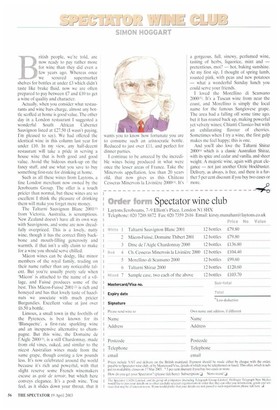B ritish people, we're told, are now ready to pay rather
more for wine than they did even a few years ago. Whereas once we scoured supermarket shelves for bottles at under £3 which didn't taste like brake fluid, now we are often prepared to pay between £7 and il 0 to get a wine of quality and character.
Actually, when you consider what restaurants and wine bars charge, almost any bottle scoffed at home is good value. The other day in a London restaurant I suggested a wonderful South African Cabernet Sauvignon listed at £27.50 (I wasn't paying, I'm pleased to say). We had offered the identical wine in this column last year for under £10. In my view, any half-decent restaurant will take a pride in serving a house wine that is both good and good value. Avoid the hideous mark-up on the fancy stuff, and use what you save to buy something first-rate for drinking at home.
Such as all these wines from Laytons, a fine London merchant now owned by the Jeroboams Group. The offer is a touch pricier than normal, but these wines are so excellent I think the pleasure of drinking them will make you forget mere money.
The Taltarni Sauvignon Blanc 20011') from Victoria, Australia, is scrumptious. New Zealand doesn't have all its own way with Sauvignons, and some are now dreadfully overpriced. This is a lovely, nutty wine, though it has the correct flinty backbone and mouth-filling generosity and warmth, if that isn't a silly claim to make for a wine you should serve chilled.
Macon wines can be dodgy, like minor members of the royal family, trading on their name rather than any noticeable talent. But you're usually pretty safe when 'Macon' is attached to the name of a village, and Fuisse produces some of the best. This Macon-Fuisse 2001(21 is rich and honeyed and has that lovely taste of hazelnuts we associate with much pricier Burgundies. Excellent value at just over £6.50 a bottle.
Limoux, a small town in the foothills of the Pyrenees, is best known for its 'Blanquette', a first-rate sparkling wine and an inexpensive alternative to champagne. But this wine, the Domaine de l'Aigle 20000), is a still Chardonnay, made from old vines, oaked, and similar to the nicest Australian wines made from the same grape, though costing a few pounds less. It's now celebrated around the world because it's rich and powerful, with that slight reserve some French winemakers excuse as goat de terroir, but which here conveys elegance. It's a posh wine. You feel, as it slides down your throat, that it
wants you to know how fortunate you are to consume such an aristocratic bottle. Reduced to just over £11, and perfect for dinner parties.
I continue to be amazed by the incredible wines being produced in what were once the lesser areas of France. Take the Minervois appellation, less than 20 years old, that now gives us this Chateau Cesseras Minervois la Liviniere 200014). It's
a gorgeous, full, sinewy, perfumed wine, tasting of herbs, liquorice, mint and — pretentious, moi? — hot, baking sunshine. At my first sip, I thought of spring lamb, roasted pink, with peas and new potatoes — what a wonderful Sunday lunch you could serve your friends.
I loved the Morellino di Scansano 200015). It's a Tuscan wine from near the coast, and Morellino is simply the local name for the famous Sangiovese grape. The area had a falling off some time ago, but it has roared back up, making powerful yet velvety wines; Chianti Classico but with an exhilarating flavour of cherries. Sometimes when I try a wine, the first gulp makes me feel happy; this is one.
And you'll also love the Taltarni Shiraz 2000(6) which is a classic Australian Shiraz, with its spice and cedar and vanilla, and sheer weight. A majestic wine, again with great elegance — not just another Ozzie blockbuster. Delivery, as always, is free, and there is a further 5 per cent discount if you buy two cases or more.


































































 Previous page
Previous page